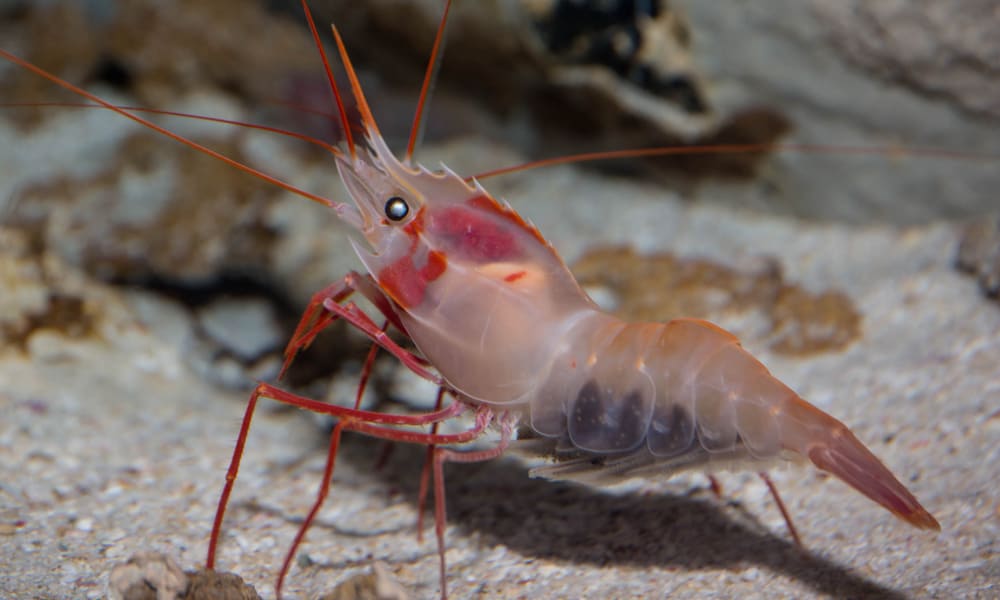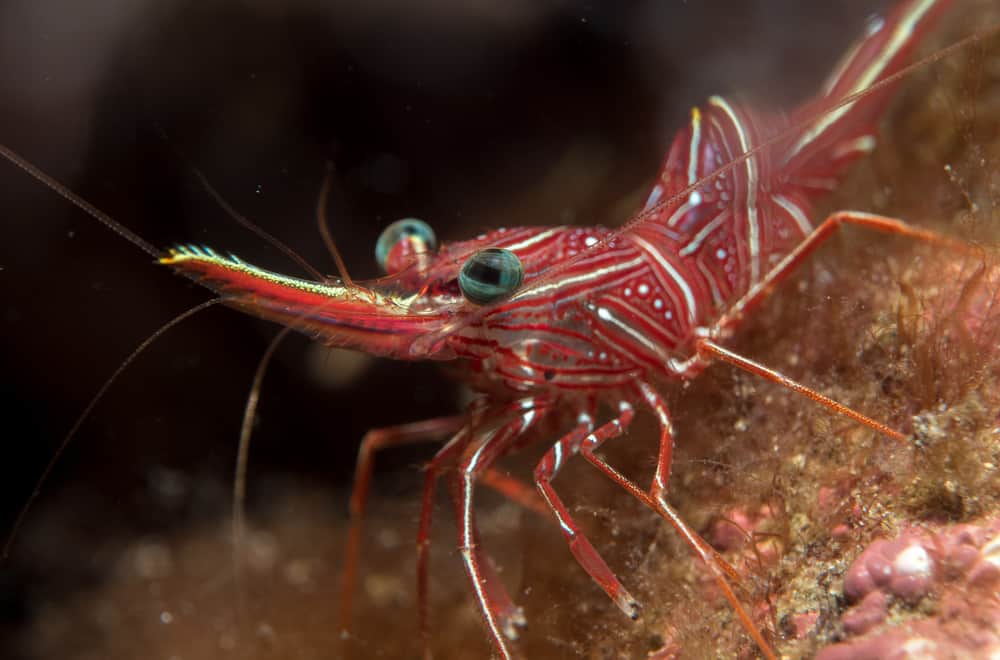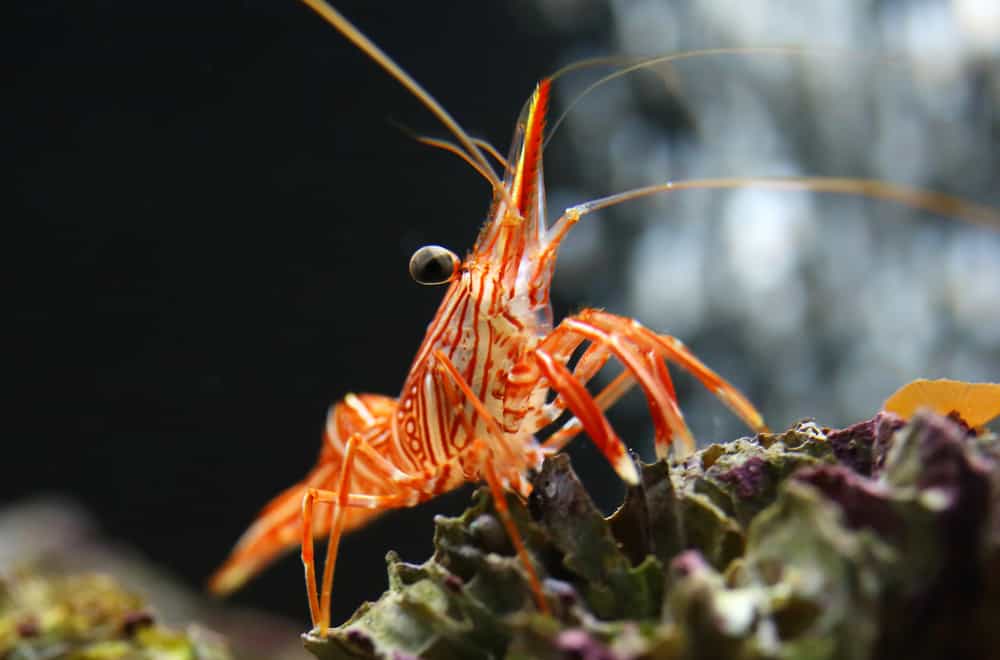Shrimps belong to the sea crab family with a long body flat on the sides. They are usually slight orange with pinky tones. Female shrimps can grow up to 7 inches (18 cm), while males typically reach up to 10 inches (25 cm). You probably agree that shrimps are delicious food for humans, but let’s take a look at what do shrimps eat.
What Do Shrimps Eat in the Wild?
Shrimp diet differs on the stage of their growth and water where they live. They are primary scavengers and will eat everything organic they can find in their environment. Those that live in the ocean have a pretty similar diet to shrimps kept in an aquarium.
Shrimp start their lives very close to the seashore, only a couple of miles away, where eggs sink and go straight to the bottom of the ocean. They begin as tiny larvae that look similar to mites and then start floating to the top of the water surface after some time.
They go through different larvae stages and slowly start to look like adults over time. Adults soon find their way back to the bottom of the ocean, where they keep living as scavengers.
Only about a quarter of all shrimps live in freshwater. Freshwater shrimps find their natural living environment in rivers and lakes, and they are usually the only scavengers in this environment type.
Their primary food resource is green growth, which usually floats in the water. Even though shrimp survive by snacking live plants, they are too small to harm them significantly.
Contingent upon their size, shrimps can likewise eat microbes, little dead fish, or plankton. In other words, they are omnivores and can eat practically anything they find on the bottom of the waterway. The inherent thing to most crustaceans is their tendency to eat their own species sometimes, which also goes for shrimps.
Well, shrimp need to shed, which means they once in a while shed their shell as they grow out of it. It requires a couple of hours for their new shells to solidify, and they are pretty helpless against predators during that time.
In this situation, larger shrimps may exploit the natural circumstance and eat these delicate individuals.
When arranging the eating regimen for the shrimp in your aquarium, you need to follow what they eat in their natural habitat. The ideal way to ensure that your shrimps feel good is to imitate their well-known environment and climate.
As I have already mentioned, shrimps usually eat microscopic creatures that they find on the bottom of the ocean. However, these omnivores can consume everything that fits inside their mouth, including tiny fish and green growth. Basically, you can put creatures that shrimps eat in the wild in four groups:
- Carcasses – Since shrimp are scavengers, carcasses are their primary food. They will clean the ecosystem by removing dead clams, sea snails, and even fish and whales’ bodies.
- Plankton – You can find these microscopic organisms in oceans, seas, and even rivers floating through the water, but it is hard to see them by the naked eye. Shrimps enjoy adding these creatures to their regular meals.
- Small fish – Shrimps can effortlessly find food among numerous sorts of small fish available. They are a true delicacy for these crustaceans.
- Algae – Algae are green growths that never flowers. They are very widely spread, and you can spot them on every water surface. Therefore, this is a perfect and readily available food for shrimps.
Facts About Shrimps
1. Biology
You can find more than 2,000 different shrimps species in warm waters and cold ones all around the globe. An average shrimp goes through 16 different stages of life, and each of them changes its size.
However, their final size is not precisely defined, and you can find tiny ones that are only about 0.5 inches (1.2 cm) long from head to tail. On the other hand, some of these crustaceans can grow up to 12 inches (30 cm).
For instance, Tiger shrimp is a unique species in the Gulf that can grow up to an adult’s forearm length. They are usually meatier than an average lobster.
Interestingly, shrimps are fantastic swimmers. They can use muscles from different muscle groups located in their tail to swim both backward and forward.
Even though you find the ocean a peaceful and calm place great for afternoon relaxation, it is actually not the case. In reality, many creepy noises appear below the water’s surface.
One of them occurs when shrimps snap their pincers. In fact, some shrimp species produce one of the loudest noises in the ocean by snapping their small and large pincers. Many experts believe that shrimps use these methods to:
- Communicate
- Confuse predators and gain some time for a runaway plan
2. Shrimps body structure
Shrimps can move each eye independently because they have around 16 photoreceptors.
Their bodies contain two pieces, including the thorax and the head. For the connection of those two pieces, there are a cephalothorax and a narrow abdomen.
They use their hard shell for protection, but you can spot gills between the shell pieces that provide oxygen from the surrounding water. The weirdest thing is that their hearts are on the very bottom of their heads.
Shrimps don’t have a long and strong backbone or any skeleton inside their bodies. They live in a long and hard shell-looking exoskeleton that protects their organs and gives them a recognizable shape. Therefore, it is necessary to remove that shield piece by piece before taking a bite of cooked shrimp.
These creatures need a bigger shield as they get older and grow. Therefore, they often replace their shields as they go through different life stages and usually shred once a week while they are still small.
Shrimps are very similar to prawns because of their looks, but you can see a few differences between them. For instance, prawns are slightly greater than shrimps.
Additionally, both of them have five sets of legs, but shrimps have claws on two sets of their legs. On the other hand, prawns have them on three sets of their legs.
3. Environment
You can see shrimps in both freshwater and saltwater. They are not territorial, and they will quickly adapt to new water and almost every new environment. As a result, you can find shrimps everywhere in the world. In fact, they live in every water body except freezing Antarctica waters.
4. Predator and prey
Shrimps will eat fish that are smaller than them, but there are always bigger predators out there. In other words, shrimps are a significant part of the ecosystem because they are a food source for:
- Crabs
- Bigger fish
- Whales
- Seabirds
Their essential role is not only to be a food source for predators yet for their relationships with other fish. They make those relationships to help each other and clean parasites and bacteria from their hosts.
5. Human food
Experts and scientists widely believe that people started to hunt and consume shrimps as far back as 600 AD. They are a delicious part of human nutrition and a perfect part of dinner. Take care to avoid putting them in the microwave when it is necessary to defrost a bag of these crustaceans quickly.
The problem is that shrimps go from a frozen to an overcooked dish in a second. It is better to put them under the stream of cold water for 10 to 15 minutes for slowly defrosting. An even better option is to put them in the fridge 24 hours before you plan to prepare them.
Besides their delicious taste, shrimps are very healthy and commonly used in healthy diets. They are low in calories that primarily (90%) come from proteins, and a serving of 3 ounces (85 g) medium-cooked shrimp has only 84 calories. Plus, shrimps are a valuable source of omega-3 fatty acids that mammals can’t produce by themselves.
Keep in mind that shrimps are very healthy for humans because they have cancer-fighting minerals. They contain selenium, an antioxidant mineral that activates enzymes that fight free radicals directly responsive for causing cancer. Consuming shrimps can prevent and reduce the risk of this horrible disease.
6. Shrimps fishing
Most shrimps are very effective breeding machines because they can lay up to one million eggs at once. Only a couple of hours later, female shrimps will carry another series of fertilized embryos. Laid eggs need less than two weeks to start hatching.
Bycatch is the biggest problem when it comes to shrimp fishing. The reproduction rate of shrimps is very high, and you can’t endanger them no matter how much you catch them. The problem is that many other fish and sea animals end up caught in the fishing net while, and there is no way to prevent that.
Summary
Shrimps are yummy sea animals that are closer to crabs rather than fish. They have a significant role in the underwater ecosystem because they clean the ocean bottom and are a food source for other sea animals. They are also a delicious meal when appropriately prepared.


